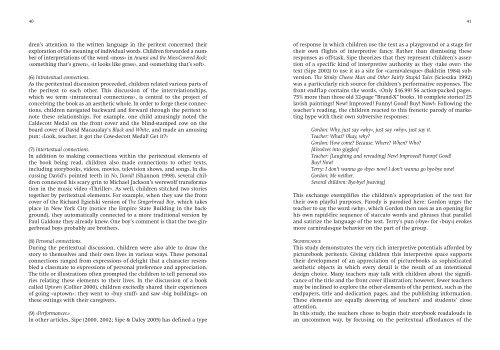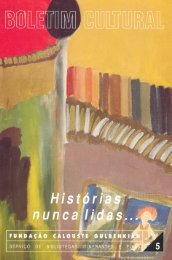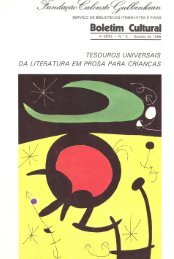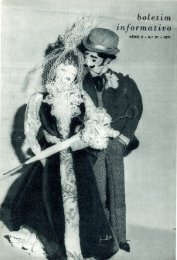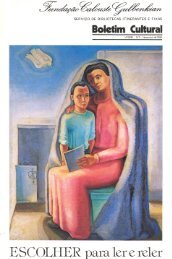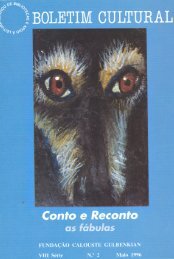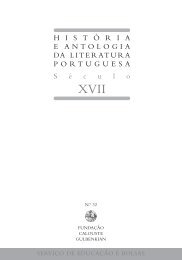Formar Leitores para Ler o Mundo - Leitura Gulbenkian - Fundação ...
Formar Leitores para Ler o Mundo - Leitura Gulbenkian - Fundação ...
Formar Leitores para Ler o Mundo - Leitura Gulbenkian - Fundação ...
Create successful ePaper yourself
Turn your PDF publications into a flip-book with our unique Google optimized e-Paper software.
40<br />
dren’s attention to the written language in the peritext concerned their<br />
exploration of the meaning of individual words. Children forwarded a number<br />
of interpretations of the word «moss» in Anansi and the Moss-Covered Rock:<br />
«something that’s green», «it looks like grass», and «something that’s soft».<br />
(6) Intratextual connections.<br />
As the peritextual discussion proceeded, children related various parts of<br />
the peritext to each other. This discussion of the interrelationships,<br />
which we term «intratextual connections», is central to the project of<br />
conceiving the book as an aesthetic whole. In order to forge these connections,<br />
children navigated backward and forward through the peritext to<br />
note these relationships. For example, one child amusingly noted the<br />
Caldecott Medal on the front cover and the blind-stamped cow on the<br />
board cover of David Macaualay’s Black and White, and made an amusing<br />
pun: «Look, teacher, it got the Cow-decott Medal! Get it?»<br />
(7) Intertextual connections.<br />
In addition to making connections within the peritextual elements of<br />
the book being read, children also made connections to other texts,<br />
including storybooks, videos, movies, television shows, and songs. In discussing<br />
David’s pointed teeth in No, David! (Shannon 1998), several children<br />
connected his scary grin to Michael Jackson’s werewolf transformation<br />
in the music video «Thriller». As well, children stitched two stories<br />
together by peritextual elements. For example, when they saw the front<br />
cover of the Richard Egielski version of The Gingerbread Boy, which takes<br />
place in New York City (notice the Empire State Building in the background),<br />
they automatically connected to a more traditional version by<br />
Paul Galdone they already knew. One boy’s comment is that the two gingerbread<br />
boys probably are brothers.<br />
(8) Personal connections.<br />
During the peritextual discussion, children were also able to draw the<br />
story to themselves and their own lives in various ways. These personal<br />
connections ranged from expressions of delight that a character resembled<br />
a classmate to expressions of personal preference and appreciation.<br />
The title or illustrations often prompted the children to tell personal stories<br />
relating these elements to their lives. In the discussion of a book<br />
called Uptown (Collier 2000), children excitedly shared their experiences<br />
of going «uptown»: they went to «buy stuff» and saw «big buildings» on<br />
these outings with their caregivers.<br />
(9) «Performances.»<br />
In other articles, Sipe (2000, 2002; Sipe & Daley 2005) has defined a type<br />
of response in which children use the text as a playground or a stage for<br />
their own flights of interpretive fancy. Rather than dismissing these<br />
responses as off-task, Sipe theorizes that they represent children’s assertion<br />
of a specific kind of interpretive authority as they «take over» the<br />
text (Sipe 2002) to use it as a site for «carnivalesque» (Bakhtin 1984) subversion.<br />
The Stinky Cheese Man and Other Fairly Stupid Tales (Scieszka 1992)<br />
was a particularly rich source for children’s performative responses. The<br />
front endflap contains the words, «Only $16.99! 56 action-packed pages.<br />
75% more than those old 32-page “Brand-X” books. 10 complete stories! 25<br />
lavish paintings! New! Improved! Funny! Good! Buy! Now!» Following the<br />
teacher’s reading, the children reacted to this frenetic parody of marketing<br />
hype with their own subversive responses:<br />
Gordon: Why, just say «why», just say «why», just say it.<br />
Teacher: What? Okay, why?<br />
Gordon: How come? Because. Where? When? Who?<br />
[dissolves into giggles]<br />
Teacher: [Laughing and rereading] New! Improved! Funny! Good!<br />
Buy! Now!<br />
Terry: I don’t wanna go «bye» now! I don’t wanna go bye-bye now!<br />
Gordon: Me neither.<br />
Several children: Bye-bye! [waving]<br />
This exchange exemplifies the children’s appropriation of the text for<br />
their own playful purposes. Parody is parodied here: Gordon urges the<br />
teacher to say the word «why», which Gordon then uses as an opening for<br />
his own rapid-fire sequence of staccato words and phrases that <strong>para</strong>llel<br />
and satirize the language of the text. Terry’s pun («bye» for «buy») evokes<br />
more carnivalesque behavior on the part of the group.<br />
SIGNIFICANCE<br />
This study demonstrates the very rich interpretive potentials afforded by<br />
picturebook peritexts. Giving children this interpretive space supports<br />
their development of an appreciation of picturebooks as sophisticated<br />
aesthetic objects in which every detail is the result of an intentional<br />
design choice. Many teachers may talk with children about the significance<br />
of the title and the front cover illustration; however, fewer teachers<br />
may be inclined to explore the other elements of the peritext, such as the<br />
endpapers, title and dedication pages, and the publishing information.<br />
These elements are equally deserving of teachers’ and students’ close<br />
attention.<br />
In this study, the teachers chose to begin their storybook readalouds in<br />
an uncommon way, by focusing on the peritextual affordances of the<br />
41


